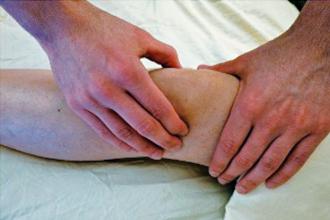Groin pain diagnosis
The groin is defined as the area where the upper thigh and lower abdomen meet. In examining this area, it’s important to know the local anatomy and the referral patterns of pain from distant structures. One way of thinking about the causes of pain in the groin is to consider the soft tissue structures that lie above and below the inguinal ligament, and to be aware of the differences that may arise between the sexes.
Structures above the inguinal ligament
Groin pain may be caused by problems arising in the lumbar spine, ileopsoas soft tissues, kidney and ureter, or intra-abdominal structures. In females, this might include a pregnant uterus. The pain may be referred from any of these structures, and a psoas abscess may present as a fluctuant swelling in the groin area. In athletes, an abdominal hernia may also present as groin pain.
Structures below the inguinal ligament
The direct or indirect inguinal hernia is the most common cause of groin pain, particularly in young workers involved in moderate to heavy work. A less common source of groin pain, particularly in females, is a femoral hernia. On examination, any signs of pain and swelling should be differentiated from enlarged lymph nodes. In the male, pathology in the scrotum and external genitalia may also cause symptoms in the groin area.
Musculoskeletal pain
In young, active individuals, groin pain may indicate a soft tissue sprain, such as those seen in athletes. On examination, the tenderness is usually found to be related to the origin of the abductor muscle in the inner thigh, and is frequently (but not always) related to physical activity.
Osteitis pubis during pregnancy or instability of the symphysis pubis may also cause complaints of pain in this area.
In older individuals, pathology arising from the hip joint or supporting structures may also cause complaints of pain in the groin area. Among this group, the more common conditions giving rise to symptoms in this area include degenerative joint disease of the hip joint, or bony metastases.
Examination for diagnosis
Most of the preceding pathologies can be diagnosed with a careful history and a physical examination. The examination should start with the lumbar spine and include the lower abdomen, musculoskeletal structures of the hip joint and surrounding soft tissue, and external genitalia when indicated.
Treatment for groin pain
Treatment for groin pain is based on diagnosis. For soft tissue injuries such as a groin sprain, the most successful forms of treatment are usually local modalities and active rehabilitation. The symptoms may take 2 to 3 months to settle, and the patient may need to restrict his or her activities during this time.
For information or assistance
If you have questions or require assistance regarding a worker patient who is experiencing groin pain, please contact a medical advisor in your nearest WorkSafeBC office.
—Jonathan Fenton MD, FRCS
WorkSafeBC Orthopaedic Consultant
14th Annual WorkSafeBC Physician Education Conference
Saturday, 19 October 2013 • Hotel Eldorado, Kelowna BC
Plenary Sessions:
• The shoulder: Common conditions
• Preventing needless disability: Tips for practising physicians
• Addiction matters: If I had known then what I know now
• Responsible prescribing of opioids and other potentially addictive medications
Workshops:
• A worksite assessment at Sun-Rype Products Ltd.
• Examination of the shoulder
• Examination of the hand/wrist
• Case studies: Pain/addiction/personality disorders
• Using tools and cases to implement opioid prescribing guidelines
• Environmental air quality
• Pearls and pitfalls: Returning your patient to work
For more information contact Jocelyne Fidyk:
604 231-8651 or 1 877 231-8765 • Jocelyne.Fidyk@worksafebc.com
www.worksafebcphysicians.com
hidden
This article is the opinion of WorkSafeBC and has not been peer reviewed by the BCMJ Editorial Board.

